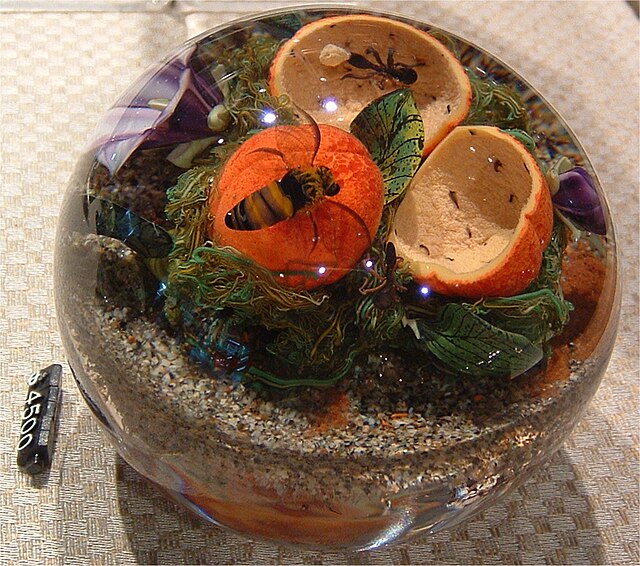Studio glass is the modern use of glass as an artistic medium to produce sculptures or three-dimensional artworks in the fine arts. The glass objects created are intended to make a sculptural or decorative statement, and typically serve no useful function. Though usage varies, the term is properly restricted to glass made as art in small workshops, typically with the personal involvement of the artist who designed the piece. This is in contrast to art glass, made by craftsmen in factories, and glass art, covering the whole range of glass with artistic interest made throughout history. Both art glass and studio glass originate in the 19th century, and the terms compare with studio pottery and art pottery, but in glass the term "studio glass" is mostly used for work made in the period beginning in the 1960s with a major revival in interest in artistic glassmaking.

Handmade studio glass using complex techniques to achieve highly detailed patterns through murrine or caneworking, by American artist David Patchen
Paperweight with items inside the glass, Corning Museum of Glass
A vase being created at the Reijmyre glassworks, Sweden
Nuptial bowl by Angelo Barovier, Murano Glass Museum
In European academic traditions, fine art is made primarily for aesthetics or creative expression, distinguishing it from decorative art or applied art, which also has to serve some practical function, such as pottery or most metalwork. In the aesthetic theories developed in the Italian Renaissance, the highest art was that which allowed the full expression and display of the artist's imagination, unrestricted by any of the practical considerations involved in, say, making and decorating a teapot. It was also considered important that making the artwork did not involve dividing the work between different individuals with specialized skills, as might be necessary with a piece of furniture, for example. Even within the fine arts, there was a hierarchy of genres based on the amount of creative imagination required, with history painting placed higher than still life.
Self-Portrait with Two Circles by Rembrandt, c.1665–1669. Kenwood House, London
The Art of Painting; by Johannes Vermeer; 1666–1668; oil on canvas; 1.3 × 1.1 m; Kunsthistorisches Museum (Vienna, Austria)
The Tower of Babel; by Pieter Bruegel the Elder; 1563; oil on panel: 1.14 × 1.55 m; Kunsthistorisches Museum
Kazimir Malevich, Black Square, 1915, oil on linen, 79.5 x 79.5 cm, Tretyakov Gallery, Moscow.








